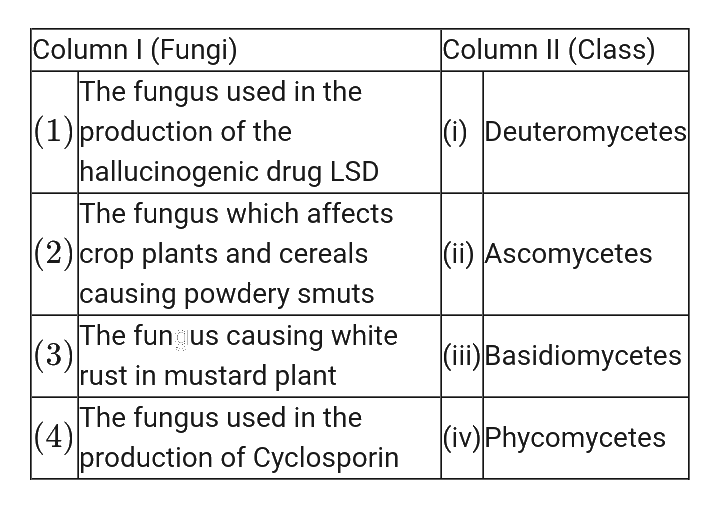Organisms without nucleus and cell organelles belong to
(i) fungi (ii) protista
(iii) cyanobacteria (iv) archaebacteria
(i) and (ii)
(iii) and (iv)
(i) and (iv)
(ii) and (iv)
The correct Answer is:B
Step by step video, text & image solution for Organisms without nucleus and cell organelles belong to (i) fungi (ii) protista (iii) cyanobacteria (iv) archaebacteria by Biology experts to help you in doubts & scoring excellent marks in Class 9 exams.
Updated on:21/07/2023Topper's Solved these Questions
- DIVERSITY IN LIVING ORGANISMS BOOK - PRADEEPCHAPTER - DIVERSITY IN LIVING ORGANISMS EXERCISE - SHORT ANSWER QUESTIONS
101 Videos
- DIVERSITY IN LIVING ORGANISMS BOOK - PRADEEPCHAPTER - DIVERSITY IN LIVING ORGANISMS EXERCISE - LONG ANSWER QUESTIONS
15 Videos
- DIVERSITY IN LIVING ORGANISMS BOOK - PRADEEPCHAPTER - DIVERSITY IN LIVING ORGANISMS EXERCISE - NCERT EXERCISES
6 Videos
- HEALTH AND DISEASESBOOK - PRADEEPCHAPTER - HEALTH AND DISEASESEXERCISE - Analytical
12 Videos
Similar Questions
Wittakar proposed five kingdom classification,
View SolutionWrite names of few thallophytes. Draw a well labelled diagram of Spirogyra.
View SolutionWhat are the advantages of classifying organisms ?
View SolutionGovernment has recently taken series of steps to minimise cigarette smoking and tobacco chewing by peopole these are injurous to health.
(i) List at least three steps taken by government to aware people about harmful effects of cigarette smoking and tobacco chewing.
(ii) What is passive smoking?
(iii) List at least one chronic disease that occurs due to continuous use of tobacco.
View SolutionOrganisms without nucleus and cell organelles belong to (i) fungi (ii) protista (iii) cyanobacteria (iv) archaebacteria
View SolutionWhich of the following belong to a distinct category ?
(a) (i) Nucleus (ii) vacuole (iii) cell wall (iv) chloroplast
(b) (i) Nucleus (ii) Nucleoli (iii) centriole (iv) chromosome
(c) (i) Centriole (ii) basal body (iii) flagella (iv) microvilli
View SolutionArchaebacteria differ from eubacteria because archaebacteria contains
I. histone proteins
II. Ether linkage in membrane lipids
III. Membrane bound nucleus
IV. Membrane bound cell organelles
View SolutionA cell organelle common in Protista and Monera is
View Solutionसंगठित केन्द्रक विहीन कोशिका है
View SolutionSelect the combination that correctly marches the fungi to respective class. {:(,(1),(2),(3),(4)),((I),i,iii,iv,ii),((II),ii,iii,iv,i),((III),iii,ii,i,iv),((IV),iv,i,ii,iii):}
View SolutionCell organelles concerned with the formation of cell plate are I. Golgi complex II. Lysosomes III. Ribosomes IV. Mitochondria
View SolutionOrganisms without nucleus and cell organelles belong to (i) fungi (ii) protista (iii) cyanobacteria (iv) archaebacteria
View Solutionबिना केंद्रक एवं कोशिकांगकों वाले जीव कौन से वर्ग में आते हैं?
(i) कवक
(ii) प्रोटिस्टा
(iii) सायनोबैक्टीरिया
(iv) आर्किबैक्टीरिया
View SolutionA cell organelle common in Protista and Monera is
View SolutionBiological classification : Classification Kingdom, Classification Systems, Kingdom Archaebacteria, Kingdom Eubacteria, Cyanobacteria, Mycoplasma, Kingdom Protista, Kingdom Fungi, Lichens, Mycorrhiza, Virus & Viriods.
View SolutionSelect the combination that correctly marches the fungi to respective class.

(1)(2)(3)(4)(I)iiiiivii(II)iiiiiivi(III)iiiiiiiv(IV)iviiiiii
View Solution
